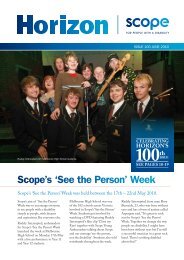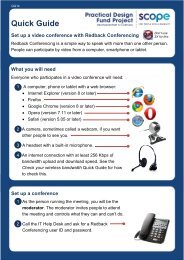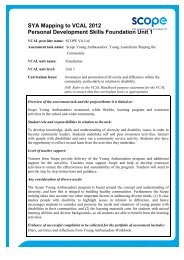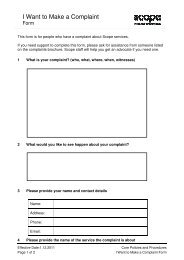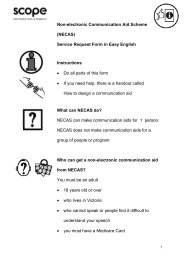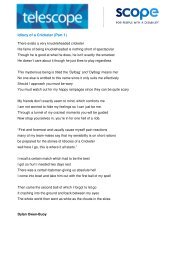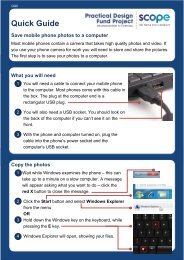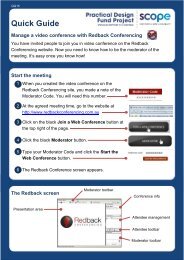Positive behaviour support Getting it right from the start
Positive behaviour support Getting it right from the start
Positive behaviour support Getting it right from the start
Create successful ePaper yourself
Turn your PDF publications into a flip-book with our unique Google optimized e-Paper software.
62 <strong>Pos<strong>it</strong>ive</strong> <strong>behaviour</strong> <strong>support</strong>: <strong>Getting</strong> <strong>it</strong> <strong>right</strong> <strong>from</strong> <strong>the</strong> <strong>start</strong> - Facil<strong>it</strong>ators reference manual<br />
PowerPoint 88<br />
*<br />
Setting, trigger, action, result (STAR) chart<br />
Date and<br />
time<br />
Who is<br />
completing<br />
<strong>the</strong> form<br />
Setting<br />
Where? Who was<br />
<strong>the</strong>re? What was<br />
happening?<br />
Trigger<br />
What happened<br />
immediately<br />
before <strong>the</strong><br />
incident?<br />
Action<br />
What did <strong>the</strong><br />
person do?<br />
Describe <strong>the</strong><br />
incident?<br />
Result<br />
What happened<br />
<strong>the</strong>n?<br />
PowerPoint 89<br />
PowerPoint 90<br />
*<br />
*<br />
Describe where<br />
<strong>the</strong> incident took<br />
place and where<br />
<strong>the</strong> person had<br />
been.<br />
Detail what <strong>the</strong><br />
environment was<br />
like (e.g. hot, cold,<br />
crowded, busy<br />
w<strong>it</strong>h activ<strong>it</strong>y)<br />
Detail what <strong>the</strong><br />
person was<br />
engaged in prior<br />
to <strong>the</strong> <strong>behaviour</strong><br />
(e.g. making a<br />
drink, watching TV,<br />
interacting w<strong>it</strong>h<br />
o<strong>the</strong>rs, reading,<br />
listening to music)<br />
Tips for completing a STAR chart<br />
• Record only what you observe yourself.<br />
Describe who was<br />
w<strong>it</strong>h <strong>the</strong> person<br />
and what <strong>the</strong>y<br />
were doing, or not<br />
doing at <strong>the</strong> time.<br />
Was <strong>the</strong> person’s<br />
routine disrupted?<br />
Was <strong>the</strong> person<br />
unwell?<br />
Was <strong>the</strong> person<br />
attempting to<br />
communicate and<br />
need or want?<br />
Describe precisely<br />
what happened.<br />
What did <strong>the</strong><br />
<strong>behaviour</strong> look,<br />
sound and feel<br />
like?<br />
Wr<strong>it</strong>e <strong>it</strong> like<br />
directions for a<br />
stage play. So<br />
someone who<br />
has never seen<br />
<strong>the</strong> <strong>behaviour</strong><br />
could clearly<br />
imagine what <strong>the</strong><br />
<strong>behaviour</strong> episode<br />
looked like.<br />
• Record only those <strong>behaviour</strong>s that are on <strong>the</strong> agreed list of target <strong>behaviour</strong>s.<br />
• Record <strong>the</strong> target <strong>behaviour</strong> as soon as possible after <strong>it</strong> was observed by you.<br />
For <strong>the</strong> <strong>behaviour</strong> you have identified, summarise this information in a STAR Chart.<br />
What steps<br />
did you take to<br />
de-escalate <strong>the</strong><br />
person?<br />
What strategy<br />
did you employ?<br />
(e.g. active<br />
listening,<br />
relaxation,<br />
redirection,<br />
negotiation).<br />
PowerPoint 91<br />
*<br />
Chose one of <strong>the</strong> <strong>behaviour</strong>s listed above.<br />
Complete <strong>the</strong> Motivation Assessment Scale (MAS) in relation to this <strong>behaviour</strong>.<br />
This will be provided by your trainer.



